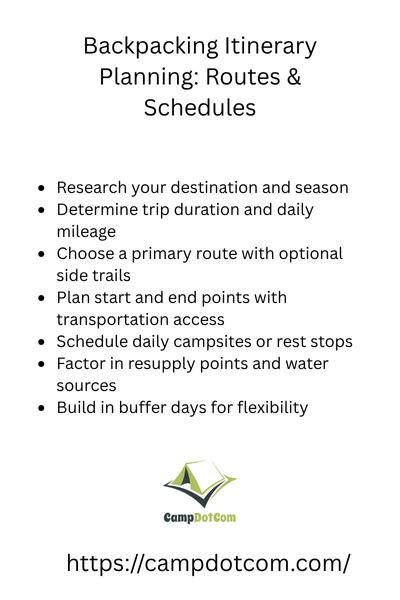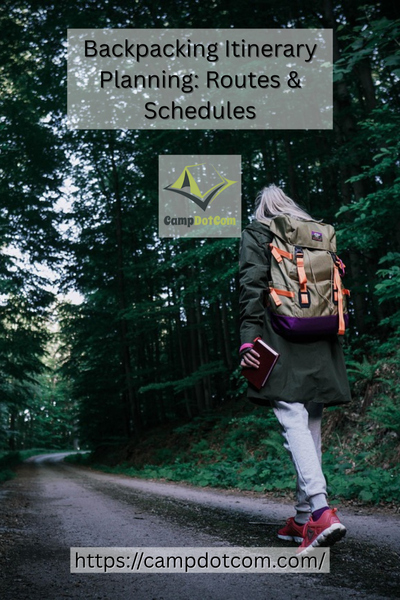So you have decided to go backpacking. That is wonderful. Now comes the part that can feel a little tricky. I have been there too, looking at maps, questioning the distance, and wondering if I am taking on more than I can handle.
The good news is you do not have to figure it all out by yourself. Let us go over how to plan your backpacking itinerary so you can step onto the trail with confidence and excitement.
Read More About Backpacking Itinerary Planning

Why Planning Your Itinerary Matters
Sure, the idea of just grabbing your pack and wandering sounds romantic, but trust me—without a solid plan, you’ll either run out of food, get lost, or find yourself hiking into the night (been there, not fun).
As an Amazon Associate, I earn from qualifying purchases. Some of the links in this article are affiliate links. This means that, at zero cost to you, I will earn an affiliate commission if you click through the link and finalize a purchase.
More Things to Know About Backpacking Itinerary Planning

A well-thought-out backpacking itinerary helps you:
- Stay on track without rushing
- Pack the right amount of food and gear
- Avoid getting stranded or exhausted
- Make the most of your adventure
Picking the Perfect Route
Before you can plan your schedule, you need to choose where you’re going.
Are you dreaming of a rugged mountain trek, a peaceful forest trail, or a coastal adventure? Your route should match your fitness level, experience, and time frame.
Consider These When Choosing a Route:
- Distance & Difficulty: Be realistic. If you’re new to backpacking, don’t start with a 100-miles trek.
- Weather & Season: A beautiful summer trail might be a snowy nightmare in winter.
- Permit Requirements: Some popular trails require permits months in advance.
- Water Sources: Carrying water is heavy. Plan around refill points.
When I first started, I made the classic mistake of picking a route based on Instagram photos alone. Turns out, that “breathtaking view” required an insane elevation gain that left me gasping. Learn from my mistake—read trail descriptions and check elevation charts.
Crafting Your Schedule
Once you’ve picked your route, it’s time to plan your daily mileage and camping spots. You want a schedule that keeps you moving but also lets you enjoy the journey.
Daily Mileage: What’s Realistic?
A solid rule of thumb: beginners should aim for five to ten miles per day, while experienced backpackers can handle 15-20 miles. But remember, it’s not just about distance—it’s about terrain. A ten miles flat trail is way different from a ten miles mountain climb.
Ask yourself:
- How much weight am I carrying?
- How often do I want to stop for photos, snacks, or side trails?
- What’s my backup plan if I get delayed?
One time, I planned a 15-miles day, forgetting about a brutal river crossing.
Spoiler: I didn’t make it. Now, I always factor in buffer time for unexpected challenges.
Setting Your Campsites
Choosing where to camp is key. You don’t want to end up pitching your tent on a rocky slope or in a mosquito-infested swamp.
Use trail maps, apps, and local forums to find the best spots. Consider:
- Water access: A nearby stream makes life easier.
- Elevation: Lower areas can be colder at night, and higher ones might be windy.
- Regulations: Some areas require you to camp only in designated sites.
Adjusting on the Go
Even the best-laid plans can change. Maybe the weather turns nasty, or your legs are just done for the day. That’s okay! Always have a Plan B and maybe a Plan C.
A flexible itinerary keeps your trip enjoyable rather than stressful. If you push too hard, you risk injury or just not having fun. Trust me, I’ve been the person stubbornly limping to a “scheduled” campsite instead of stopping at a better one a mile earlier.
Don’t be me—listen to your body.
Wrapping Up Your Backpacking Itinerary Planning Adventure
Backpacking itinerary planning doesn’t mean locking yourself into a rigid timeline. It’s about setting yourself up for success while leaving room for adventure.
With a good plan, you’ll spend less time stressing and more time soaking in epic sunrises, making trail friends, and enjoying the wild.
Grab your map, sketch out your route, and get ready for an unforgettable trip. Happy hiking.
